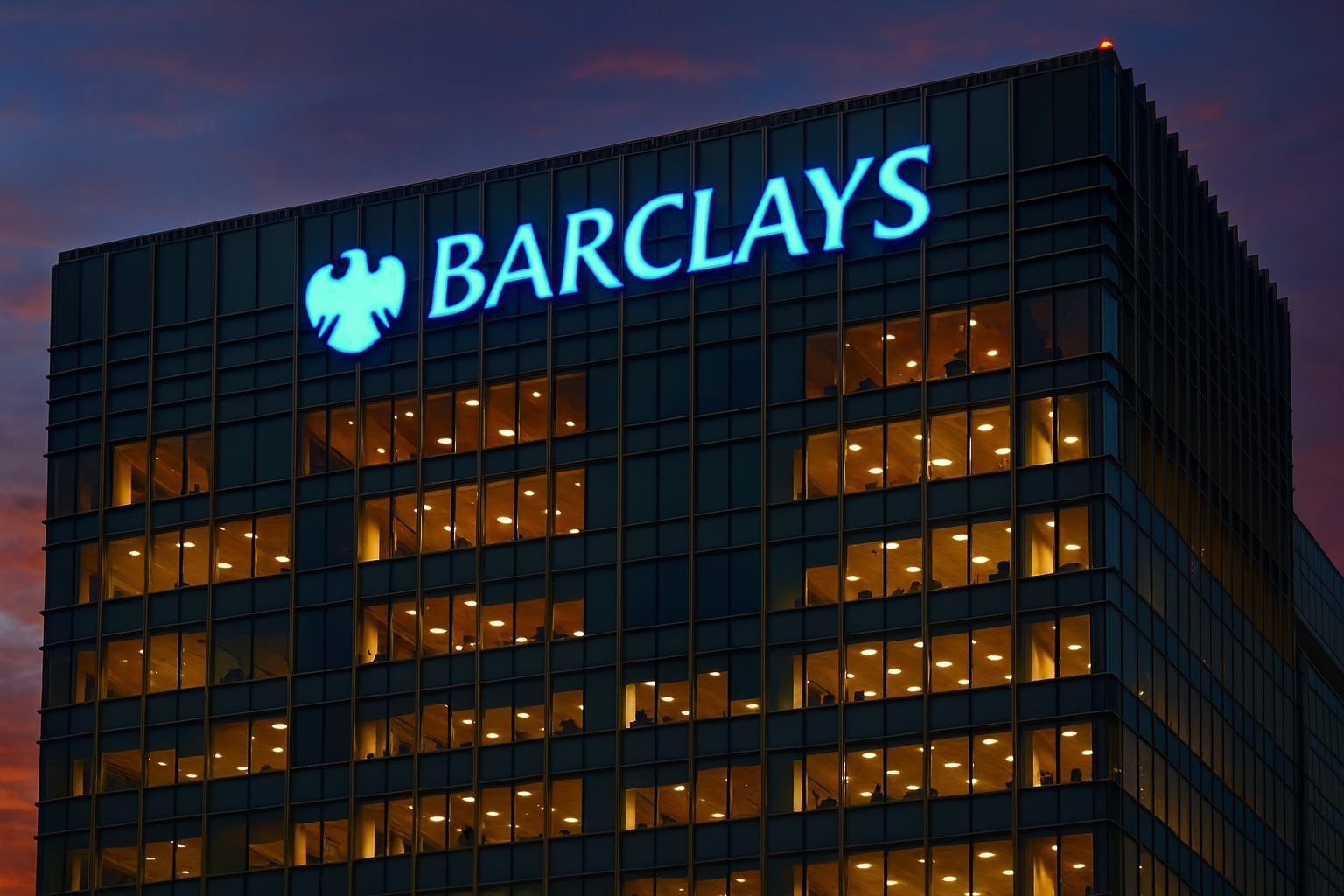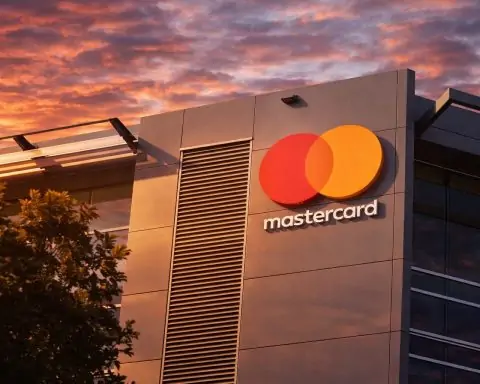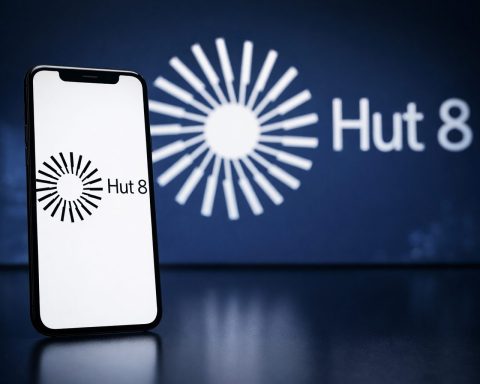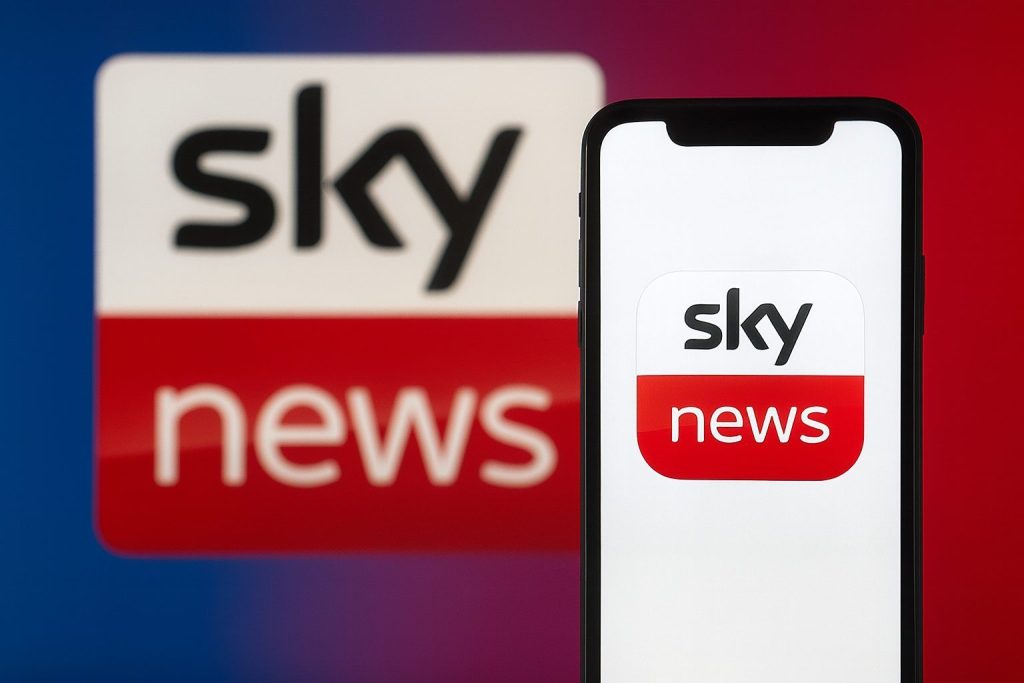London – 26 November 2025 — Barclays PLC (LON: BARC, NYSE: BCS) finished Wednesday’s session slightly higher as investors digested a fresh round of buyback news, a new liquid alternatives ETF partnership with Legal & General, and a stream of regulatory filings that underline just how busy the UK lender remains in capital markets.
Below is a full round‑up of today’s key developments around Barclays — and what they could mean for shareholders.
Barclays share price today: BARC edges higher, still crushing the FTSE 100
Barclays’ London-listed shares closed at about 413.6p on Wednesday, up 0.9% from Tuesday’s 410p finish. The stock traded between 411.4p and 415.4p intraday, on volume just under 4 million shares. [1]
That leaves Barclays with a market capitalisation of roughly £57.5bn, a price/earnings ratio of 11.4 and a forward dividend yield of just over 2% based on recent payouts. [2]
Performance over longer periods remains striking:
- 1 week: +2.6%
- 1 month: +5.6%
- 6 months: +26.8%
- 1 year: +55.5% (around 60% using monthly averages) [3]
By comparison, the FTSE 100 is up about 16–17% over the past year, meaning Barclays has comfortably outpaced the broader UK blue‑chip index. [4]
In today’s wider market, banks were again in focus ahead of the UK Autumn Budget. A Reuters midday wrap noted that UK bank stocks rose around 0.5%, with Barclays up roughly 0.8%, helped by hopes that the Chancellor will avoid a harsh new tax grab on the sector. [5]
Buyback update: 2.1m shares cancelled today, with more capital returns coming
The main company-specific news today was another “Transaction in Own Shares” announcement under Barclays’ ongoing buyback programme.
Today’s RNS: 2,105,514 shares bought back
In an RNS released this morning, Barclays confirmed it purchased and cancelled 2,105,514 ordinary shares on 25 November 2025, bought on‑market from Citigroup Global Markets Limited. The purchases form part of the share buyback announced on 30 July 2025. [6]
While that’s a relatively small slice of the share count, these daily repurchases are adding up:
- On 5 November 2025, Barclays disclosed it had repurchased 214.9 million shares at an average price of 375.76p, reducing its issued share capital to about 13.94 billion shares. [7]
- A separate filing noted the cancellation of £2m of securities due 2030, tidying up its funding stack. [8]
Today, TipRanks summarised the latest buyback moves, noting that Barclays has now cancelled more than 2 million shares under the programme and that total share capital stands at roughly 13.9 billion shares. [9]
Bigger picture: £1.5bn+ of buybacks through 2026
The current repurchase activity sits within a much larger capital‑return plan:
- In July 2025, Barclays launched a £1.0bn on‑market buyback executed by Citigroup as riskless principal. [10]
- In October, management announced a new £500m buyback to begin as soon as the existing £1bn programme finishes, running until 20 April 2026 subject to regulatory approvals. [11]
- The bank has previously guided that it aims to return at least £10bn to shareholders over 2024–2026 via dividends and buybacks, with a clear preference for the latter. [12]
Put simply: Barclays is aggressively shrinking its share count at a time when profits and returns on equity are improving, which mechanically boosts earnings per share and tends to support the share price if earnings hold up.
New L&G liquid alternatives ETF: Barclays index at the core
Away from its own equity, Barclays also grabbed attention in the ETF world today.
ETF Stream reported that Legal & General (L&G) has launched the L&G Market Neutral Commodities UCITS ETF (ticker: MANU), a “liquid alternatives” product built in partnership with Barclays. [13]
Key details:
- MANU is listed on Deutsche Börse, Borsa Italiana and SIX Swiss Exchange, with a London listing planned for 2026. [14]
- It tracks the Barclays Backwardation Tilt Alpha Capped ex‑Precious Metals 1.75x TR Index, providing a long/short, 1.75x‑leveraged strategy across energy, industrial metals, livestock and agriculture futures. [15]
- The ETF charges a 0.39% management fee plus 0.06% in expected transaction costs according to its KID. [16]
- The product builds on an existing partnership: L&G already runs the $2.2bn L&G Multi‑Strategy Enhanced Commodities UCITS ETF (ENCO), also based on a Barclays‑designed index. [17]
For Barclays shareholders, this matters less for immediate profit and more as a signal of franchise strength:
- It reinforces Barclays’ position as a major index and derivatives provider to global asset managers.
- It builds recurring index‑licensing and structuring revenue.
- It showcases the bank’s quant and commodities expertise, which can spill over into other institutional relationships.
Structured notes: new US‑listed complex products filed with the SEC
Barclays Bank PLC also continued to tap US investors via its structured notes platform, filing several new deals in Form 424B2 prospectus supplements. [18]
Highlights include:
- Autocallable market‑linked securities tied to the Nasdaq‑100 and S&P 500
- Quarterly call opportunities starting after roughly one year.
- If the worst‑performing index is at or above its starting level on a call date, investors receive principal plus a call premium equivalent to about 9.55% per year (simple).
- If the notes run to maturity, principal is protected as long as the worst index finishes above 75% of its starting level; below that, capital losses accelerate. [19]
- $2.455m Autocallable Buffered Return Enhanced Notes due November 2027
- Linked to an equally weighted basket of seven US stocks, including Microsoft, Nvidia, Meta Platforms and others.
- Offer a 17.3% call premium if the basket is at or above its initial level on the review date.
- Include a buffered downside: investors start taking leveraged losses if the basket drops beyond a preset buffer level. [20]
- Buffered dual‑directional notes due 2026
- Provide limited upside even if the underlying “least performing” asset falls modestly (up to 20%), but can expose investors to losses of up to 80% of principal if markets fall sharply. [21]
These products generate fees and funding for Barclays but are high‑risk, complex instruments generally unsuitable for most retail investors. The filings also emphasise that:
- The notes are unsecured obligations of Barclays.
- There are no periodic interest payments.
- Investors are exposed to both market risk and Barclays’ own credit risk, including potential application of UK “bail‑in” powers. [22]
Regulatory filings: B&M holding falls to zero and new Takeover Code disclosures
B&M European Value Retail TR‑1
Today’s TR‑1 major shareholding notification from B&M European Value Retail S.A. revealed that Barclays PLC and related entities now hold 0% of B&M’s voting rights, down from a previously notifiable threshold. [23]
The filing shows:
- All direct and indirect voting rights in B&M via Barclays Bank PLC, Barclays Capital Securities Limited and Barclays Capital Luxembourg S.à r.l. are now 0.000000%.
- The position sits in Barclays’ trading book and qualifies for the trading book exemption, which is why a TR‑1 was triggered as the stake fell through the reporting threshold. [24]
This doesn’t change Barclays’ core business but does give a window into how active the bank is in market‑making and derivatives around FTSE‑listed names.
Takeover Code Form 8.5: Qualcomm and American Axle
Two further Form 8.5 (EPT/Non‑RI) disclosures today show Barclays Capital Securities Ltd acting as an exempt principal trader in ongoing takeover situations: [25]
- One related to Aqua Acquisition Sub LLC, an indirect wholly owned subsidiary of Qualcomm Inc., in connection with a deal subject to the UK Takeover Code.
- Another related to American Axle & Manufacturing Holdings Inc.
The forms detail Barclays’ options and derivative positions in the relevant securities. They are routine under the Takeover Code but underline Barclays’ strong presence in event‑driven trading and M&A advisory flows.
US politician trade: small sale of Barclays ADRs by Rep. Lisa McClain
Across the Atlantic, MarketBeat highlighted a fresh disclosure from US Representative Lisa C. McClain (R‑Michigan), who reported the sale of $1,001–$15,000 worth of Barclays ADRs (NYSE: BCS) on 30 October 2025. [26]
The position size is tiny relative to Barclays’ £57bn+ market cap, so it is best viewed as personal portfolio management rather than any meaningful signal about the bank’s prospects.
Fintech competition: Revolut’s valuation now rivals Barclays
Barclays also found itself used as a yardstick in the never‑ending fintech vs. legacy bank debate.
A Finance Magnates report on a recent secondary share sale at Revolut said the London‑based fintech is now valued at roughly $75bn (about £57bn), “putting it ahead of” established banks such as Barclays, NatWest and Deutsche Bank by market value. [27]
With Barclays’ own market cap hovering around £57.5bn, the comparison is close — but the message is clear:
- Investors are willing to assign tech‑style valuations to fast‑growing private challengers.
- Public‑market incumbents like Barclays continue to trade on modest earnings multiples, despite strong recent share‑price gains.
For Barclays shareholders, that gap cuts both ways: it underlines competitive pressure, but also hints at valuation upside if the bank can keep growing returns and prove it deserves a higher multiple.
Technicals and analyst sentiment: 200‑day breakout and double‑digit upside
Today’s move may have looked modest, but from a technical and analyst‑sentiment standpoint, Barclays is in much better shape than a year ago.
Technical picture
A MarketBeat note today flagged that Barclays’ share price has moved above its 200‑day moving average, a level many traders treat as the dividing line between long‑term uptrends and downtrends. [28]
A separate analysis on DirectorsTalk put some numbers around the trend:
- The stock is trading well above its 50‑day moving average (around 390p) and even further above the 200‑day average (around 340p).
- The Relative Strength Index (RSI) is in the mid‑50s, implying positive momentum but not yet “overbought.” [29]
Taken together, that points to a strong but not yet euphoric technical set‑up.
Analyst views and price targets
On the fundamentals side, sentiment is broadly constructive:
- DirectorsTalk reports that Barclays currently carries 11 Buy ratings and 3 Hold ratings, with no Sell recommendations.
- The average price target is about 449p, implying roughly 14% upside from current levels, with a range from 337p to 525p. [30]
- TipRanks notes a recent Buy rating with a 510p target and its AI “Spark” analyst classifies GB:BARC as “Outperform”, citing strong financial performance, an attractive valuation and supportive buyback policy. [31]
Given today’s close just above 413p, these targets suggest analysts still see double‑digit upside, even after a roughly 55–60% 12‑month rally. [32]
Key risks and what to watch next
Despite all the good news, Barclays remains tied to a set of macro and policy risks that investors should keep in mind:
- UK Autumn Budget (today)
- Banks have rallied this week on reports that Chancellor Rachel Reeves will spare the sector from punishing new tax hikes, boosting optimism around future profitability. [33]
- Any surprise move on the bank levy, surcharge or financial‑transactions taxes could quickly hit sentiment.
- Interest‑rate path and credit quality
- Barclays’ net interest income is highly sensitive to Bank of England policy. A faster‑than‑expected rate‑cut cycle could pressure margins, even as it helps borrowers.
- After a long run of relatively benign impairments, a sharper slowdown could lead to higher loan‑loss charges, particularly in UK consumer and card books.
- Regulatory and conduct risk
- Barclays remains under the long shadow of historic issues: the FCA fined Barclays Bank UK £3.1m in July 2025 over weaknesses in client money account controls, and US regulators only recently launched a Fair Fund to compensate investors over past structured‑notes overselling. [34]
- While these are largely legacy matters, they show how regulatory shocks can still surprise.
- Competition from fintech and global banks
Bottom line for investors
On 26 November 2025, the story around Barclays PLC looks broadly positive:
- The share price continues to grind higher, sitting near multi‑year highs and well ahead of the FTSE 100 over 12 months. [37]
- The buyback machine is in full swing, with more than £1.5bn of repurchases either executed or committed and fresh RNS filings confirming daily share cancellations. [38]
- New ventures like the L&G market‑neutral commodities ETF and ongoing structured‑note issuance demonstrate that Barclays remains a key player in global capital markets. [39]
- Analyst sentiment is tilted to Buy, with consensus targets comfortably above today’s price and technicals pointing to an ongoing uptrend. [40]
That said, investors still need to weigh the macro, regulatory and competitive risks, especially around the Autumn Budget, interest‑rate cuts and the relentless advance of fintech challengers.
As always, this article is for information only and does not constitute investment advice. Anyone considering an investment in Barclays PLC (BARC/BCS) should do their own research or consult a qualified financial adviser, and remember that past performance is not a guide to future returns.
References
1. www.hl.co.uk, 2. www.hl.co.uk, 3. www.hl.co.uk, 4. markets.investorschronicle.co.uk, 5. www.reuters.com, 6. www.investegate.co.uk, 7. www.tradingview.com, 8. www.tradingview.com, 9. www.tipranks.com, 10. www.stocktitan.net, 11. www.investing.com, 12. home.barclays, 13. www.etfstream.com, 14. www.etfstream.com, 15. www.etfstream.com, 16. www.etfstream.com, 17. www.etfstream.com, 18. www.stocktitan.net, 19. www.stocktitan.net, 20. www.stocktitan.net, 21. www.sec.gov, 22. www.stocktitan.net, 23. www.investegate.co.uk, 24. www.investegate.co.uk, 25. www.tradingview.com, 26. www.marketbeat.com, 27. www.tradingview.com, 28. www.marketbeat.com, 29. www.directorstalkinterviews.com, 30. www.directorstalkinterviews.com, 31. www.tipranks.com, 32. www.hl.co.uk, 33. somoshermanos.mx, 34. www.fca.org.uk, 35. www.tradingview.com, 36. www.bloomberg.com, 37. www.hl.co.uk, 38. www.investegate.co.uk, 39. www.etfstream.com, 40. www.directorstalkinterviews.com








